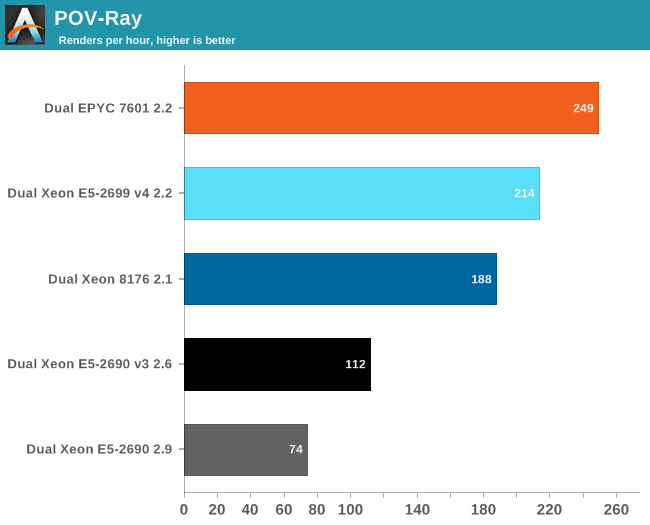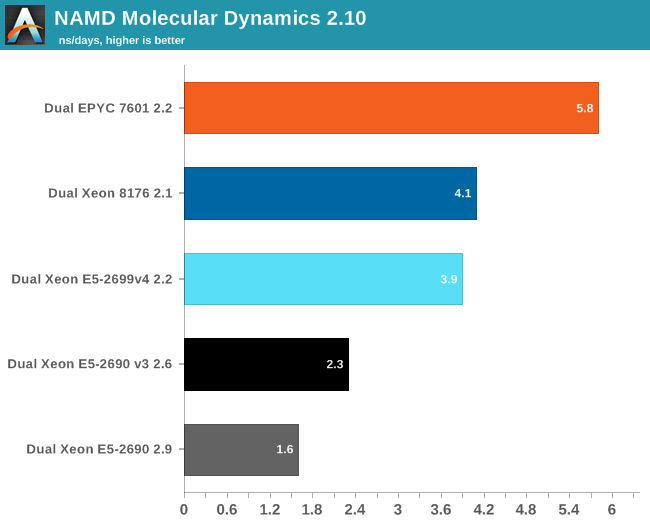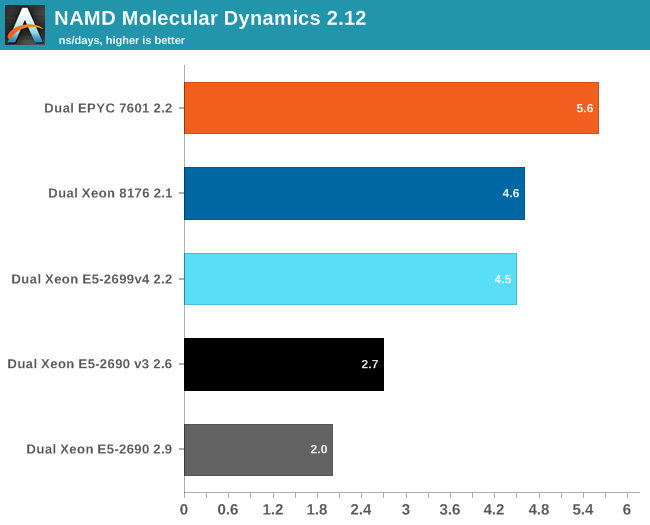Sizing Up Servers: Intel's Skylake-SP Xeon versus AMD's EPYC 7000 - The Server CPU Battle of the Decade?
by Johan De Gelas & Ian Cutress on July 11, 2017 12:15 PM EST- Posted in
- CPUs
- AMD
- Intel
- Xeon
- Enterprise
- Skylake
- Zen
- Naples
- Skylake-SP
- EPYC
Floating Point
Normally our HPC benchmarking is centered around OpenFoam, a CFD software we have used for a number of articles over the years. However, since we moved to Ubuntu 16.04, we could not get it to work anymore. So we decided to change our floating point intensive benchmark for now. For our latest article, we're testing with C-ray, POV-Ray, and NAMD.
The idea is to measure:
- A FP benchmark that is running out of the L1 (C-ray)
- A FP benchmark that is running out of the L2 (POV-Ray)
- And one that is using the memory subsytem quite often (NAMD)
Floating Point: C-ray
C-ray is an extremely simple ray-tracer which is not representative of any real world raytracing application. In fact, it is essentially a floating point benchmark that runs out of the L1-cache. Luckily it is not as synthetic and meaningless as Whetstone, as you can actually use the software to do simple raytracing.
We use the standard benchmarking resolution (3840x2160) and the "sphfract" file to measure performance. The binary was precompiled.

Wow. What just happened? It looks like a landslide victory for the raw power of the four FP pipes of Zen: the EPYC chip is no less than 50% faster than the competition. Of course, it is easy to feed FP units if everything resides in the L1. Next stop, POV-Ray.
Floating Point: POV-Ray 3.7

POV-Ray is known to run mostly out of the L2-cache, so the massive DRAM bandwidth of the EPYC CPU does not play a role here. Nevertheless, the EPYC CPU performance is pretty stunning: about 16% faster than Intel's Xeon 8176. But what if AVX and DRAM access come in to play? Let us check out NAMD.
Floating Point: NAMD
Developed by the Theoretical and Computational Biophysics Group at the University of Illinois Urbana-Champaign, NAMD is a set of parallel molecular dynamics codes for extreme parallelization on thousands of cores. NAMD is also part of SPEC CPU2006 FP. In contrast with previous FP benchmarks, the NAMD binary is compiled with Intel ICC and optimized for AVX.
First, we used the "NAMD_2.10_Linux-x86_64-multicore" binary. We used the most popular benchmark load, apoa1 (Apolipoprotein A1). The results are expressed in simulated nanoseconds per wall-clock day. We measure at 500 steps.

Again, the EPYC 7601 simply crushes the competition with 41% better performance than Intel's 28-core. Heavily vectorized code (like Linpack) might run much faster on Intel, but other FP code seems to run faster on AMD's newest FPU.
For our first shot with this benchmark, we used version 2.10 to be able to compare to our older data set. Version 2.12 seems to make better use of "Intel's compiler vectorization and auto-dispatch has improved performance for Intel processors supporting AVX instructions". So let's try again:

The older Xeons see a perforance boost of about 25%. The improvement on the new Xeons is a lot lower: about 13-15%. Remarkable is that the new binary is slower on the EPYC 7601: about 4%. That simply begs for more investigation: but the deadline was too close. Nevertheless, three different FP tests all point in the same direction: the Zen FP unit might not have the highest "peak FLOPs" in theory, there is lots of FP code out there that runs best on EPYC.










219 Comments
View All Comments
deltaFx2 - Thursday, July 13, 2017 - link
"Can you mention one innovation from AMD that changed the world?" : None. But the same applies to Intel too, save, I suppose, the founders (Moore and Noyce) contributions to IC design back when they were at Fairchild/Shockley. That's not Intel's contribution. Computer Architecture/HPC? That's IBM. They invented the field along with others like CDC. Intel is an innovator in process technology, specifically manufacturing. Or used to be... others are catching up. That 3-yr lead that INtel loves to talk about is all but gone. So with that out of the way...AMD's contributions to x86 technology: x86-64, hypertransport, integrated memory controller, multicore, just to name a few. Intel copied all of them after being absolutely hammered by Opteron. Nehalem system architecture was a copy-paste of Opteron. It is to AMD's discredit that they ceded so much ground on the CPU microarchitecture since then with badly executed Bulldozer, but it was AMD that brought high-performance features to x86 server. Intel would've just loved to keep x86 on client and Itanium on server (remember that innovative atrocity?). Then there's a bunch on the GPU side (which INtel can't get right for love or money), but that came from an acquisition, so I won't count those.
"AMD exists because they are always inferior". Remember K8? It absolutely hammered intel until 2007. Remember Intel's shenanigans bribing the likes of Dell to not carry K8? Getting fined in the EU for antitrust behaviors and settling with AMD in 2010? Not much of a memory card on you, is there?
AMD gaining even 5-10% means two things for intel: Lower margins on all but the top end (Platinum) and a loss in market share. That's plain bad for the stock.
"Intel is a data center giant have head start have the resources...". Yes, they are giants in datacenter compute. 99% market share. Only way to go from there is down. Also, those acquisitions you're talking about? Only altera applies to the datacenter. Also, remember McAfee for an eye-watering $7.8 bn? How's that working out for them?
Shankar1962 - Wednesday, July 12, 2017 - link
Nvidia who have been ahead than Intel in AI should be the more competent threatHow much market share Intel loses depends on how they compete against Nvidia
Amd will probably gain 5% by selling products for cheap prices
Intel controls 98/99% share so it's inevitable to lose a few % as more players see the money potential but unless Intel loses to Nvidia there is annuphill battle for Qualcomm ARM.
HanSolo71 - Wednesday, July 12, 2017 - link
Could you guys create a Benchmark for Virtual Desktop Solutions? These AMD chips sound awesome for something like my Horizon View environment where I have hundreds of 2 core 4GB machines.Threska - Saturday, July 22, 2017 - link
For VDI wouldn't either an APU setup, or CPU+GPU be better?msroadkill612 - Wednesday, July 12, 2017 - link
Kudos to the authors. I imagine its gratifying to have stirred such healthy & voluminous debate :)milkod2001 - Thursday, July 13, 2017 - link
Are you guys still updating BENCH results? I cannot find there benchmark results for RYZEN CPUs when i want to compare them to others.Ian Cutress - Friday, July 14, 2017 - link
They've been there since the launchAMD (Zen) Ryzen 7 1800X:
http://www.anandtech.com/bench/product/1853
KKolev - Thursday, July 13, 2017 - link
I wonder if AMD'd EPYC CPU's can be overclocked. If so, the AMD EPYC 7351P would be very interesting indeed.uklio - Thursday, July 13, 2017 - link
How could you not do Cinebench results?! we need an answer!JohanAnandtech - Thursday, July 13, 2017 - link
I only do server benchmarks, Ian does workstation. Ian helped with the introduction, he will later conduct the workstation benchmarks.